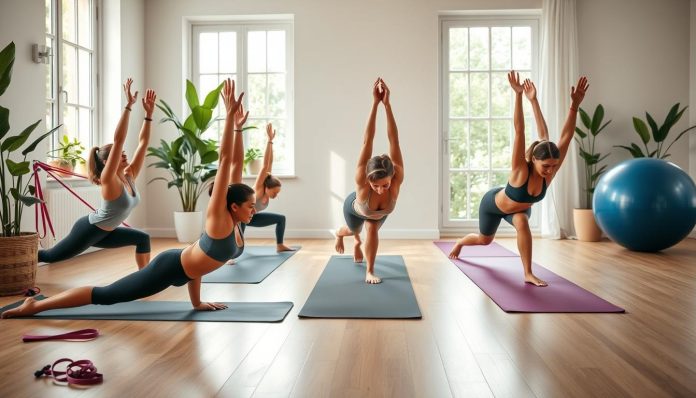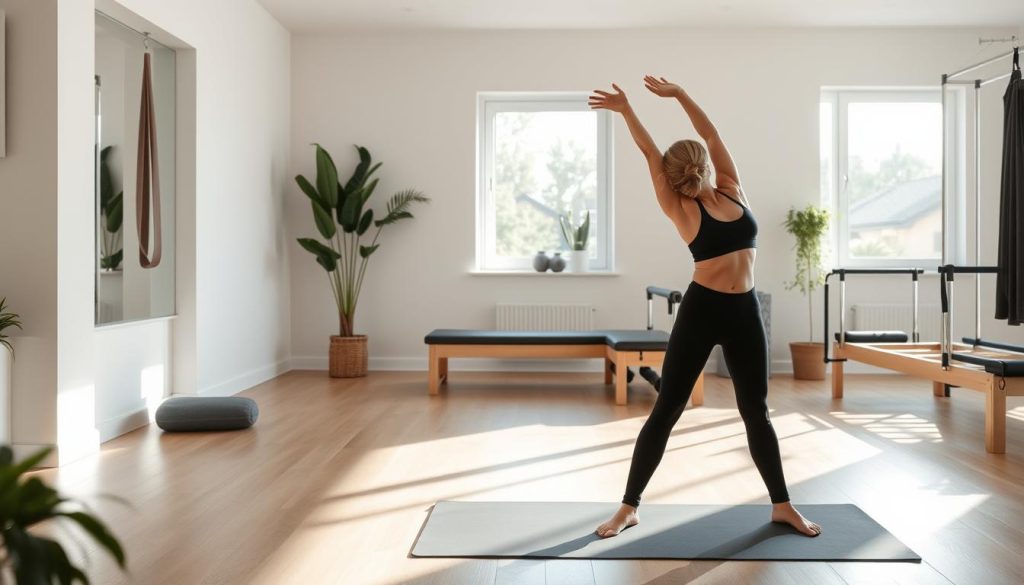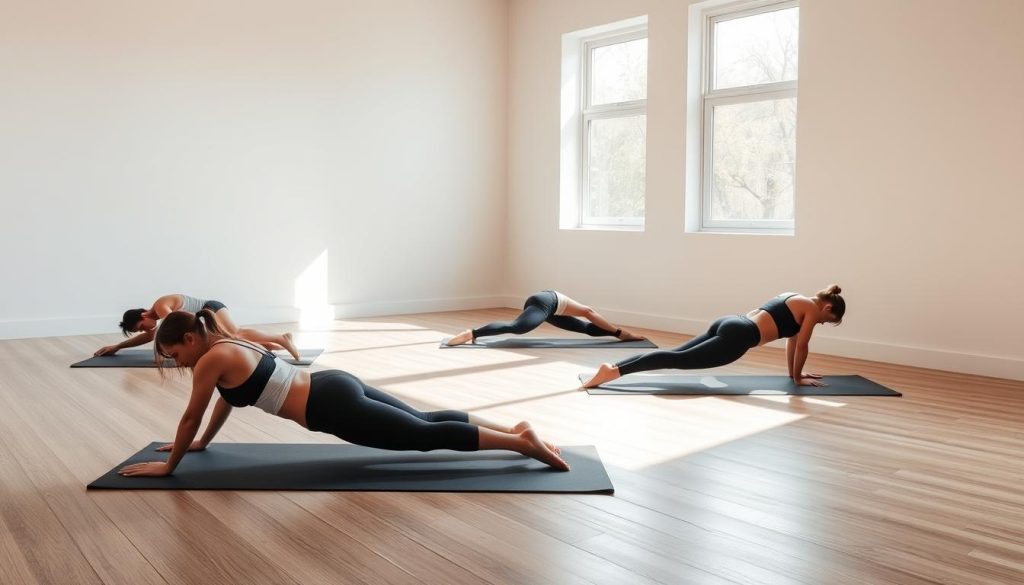Strengthening your core is key for fitness and can be done in 7 days without crunches. You can get a stronger, more toned midsection with the right exercises and tips. A 7-day core strengthening plan focuses on core muscles without crunches. It includes 19 unique exercises that take about five minutes each for best results.
To start with How to Strengthen Your Core in 7 Days, know that core exercises work the whole core, not just abs. The routine lets you mix and match exercises. It also references a 30-Day Ab Challenge for more options.
Key Takeaways
- You can strengthen your core in just 7 days without doing crunches.
- A 7-day core strengthening routine includes 19 unique core exercises.
- Each exercise can be completed in approximately five minutes for maximum efficiency.
- The routine is designed to engage the entire core, focusing on abdominal muscle toning.
- You can mix and match exercises with references to a 30-Day Ab Challenge for more options.
- Core strengthening exercises are essential for overall fitness and can help improve athletic performance.
- A strong core can help prevent falls and support overall body function.
Why Core Strength is Essential for Overall Fitness
Starting your journey to strengthen your core is key to better fitness. A good core workout routine boosts posture, balance, and sports skills. You can strengthen abs without crunches by doing planks, leg raises, and side planks.
Core strength is vital for health and fitness, studies show. The American Council on Exercise (ACE) suggests exercises for core muscles. A strong core lowers injury risk and boosts sports performance.
Understanding the Core Muscles
The core muscles are essential for posture, balance, and stability. Exercises like planks work these muscles and also engage shoulders, upper back, and hips. This improves fitness and reduces injury risk.
Benefits Beyond Aesthetics
A strong core offers more than just looks. It improves posture, cuts back pain, and boosts sports skills. A good core workout routine also helps strengthen abs without crunches. This reduces injury risk and enhances fitness.
Day 1: The Foundation of Core Workouts
Starting your 7-day journey to strengthen your core is exciting. First, check your current core strength and set achievable goals for the week. Exercises like planks and mountain climbers are key to building a strong core. Begin by seeing how long you can hold a plank, then aim to beat that time by the week’s end.
Assessing Your Current Core Strength
Try holding a plank for as long as you can to gauge your core strength. This will give you a starting point and a baseline for improvement. Make sure to use your core muscles, like the transverse abdominis, and keep the right form.
Setting Realistic Goals for the Week
After assessing your strength, set goals for the week. For instance, if you can hold a plank for 20 seconds, aim for 30 seconds by the week’s end. This will keep you motivated and help you see your progress. Add exercises like bicycle crunches and leg raises to work your core from different angles.
Day 2: Engaging in Low-Impact Pilates
As you move forward in your core strengthening plan, adding low-impact exercises is key. Pilates is a great choice because it focuses on proper form and technique. It helps build a strong core, which is vital for fitness and stability.
Your core workout should include exercises that challenge your muscles in various ways. On Day 2, focus on Pilates that targets your upper and lower abs, and obliques. The Lemon Squeezer Exercise is a good choice to help you reach your core strengthening goals.
Introduction to Pilates for Core Strength
Pilates is a low-impact exercise that can be adjusted to fit your fitness level and goals. It’s perfect for boosting your core strength, flexibility, and balance. Adding Pilates to your workout routine will help you build a strong, stable core. This will make daily activities easier and more confident.
Beginner Pilates Exercises You Can Try
Start with simple Pilates exercises if you’re new to it. Try the Hundred, Teaser, and Plank to build core strength. Always focus on proper form and technique. If needed, adjust the exercises to match your fitness level.
By adding Pilates to your core strengthening plan, you’ll build a strong, stable core. With regular practice and dedication, you can see improvements in just a few days.
Day 3: Incorporating Yoga for Stability
As you move through the 7-day core challenge, adding exercises for stability is key. Yoga is perfect for this, strengthening your core and improving flexibility and posture. It makes your core workouts even better.
Yoga poses like downward-facing dog and warrior II are great for your core. They work on the transversus abdominis, rectus abdominis, and obliques. This boosts your core strength and stability. Always focus on your breath and engage your core in each pose.
Key Yoga Poses for Core Engagement
Start with yoga poses that target the deeper core muscles. The transversus abdominis, for example, wraps around your spine and pelvis. It provides stability and support. Engaging this muscle improves your core strength and lowers back pain risk.
Mind-Body Connection in Core Workouts
A strong mind-body connection is vital for core workouts. Focus on your breath and engage your core to stay motivated and focused. This connection helps you understand your body better and adjust your workout safely and effectively. Keep prioritizing your mind-body connection as you go through the 7-day challenge.
Day 4: Bodyweight Exercises for Core Strength
As you move through your 7-day core workout, it’s key to try different exercises. Day 4 focuses on bodyweight exercises you can do anywhere, without equipment. These help boost your core strength, stability, and fitness.
A good core workout should work your upper and lower abs, obliques, and deep transverse abdominis. Try plank variations like side plank and reverse plank to strengthen your core. The side-lying leg lift targets your obliques by lifting your legs while on your side.
Plank Variations to Try
Plank exercises are great for your core, including abs, obliques, and lower back. Start in a push-up position with hands shoulder-width apart. Engage your core by pulling your belly button towards your spine. Hold for 30-60 seconds, rest for 30 seconds, and repeat for 3-5 sets.
Side-Lying Leg Lifts for Obliques
Side-lying leg lifts are effective for your obliques. Lie on your side with legs straight, then lift your top leg up. Lower it back down and repeat for 3 sets of 10-15 reps on each side. Focus on proper form and add these exercises to your daily routine for best results.
Day 5: Resistance Training Techniques
As you move forward in your core workout, adding resistance training is key. Day 5 focuses on cable machines and resistance bands. These tools help challenge your core in new ways. They also help you strengthen abs without crunches by working on your transverse abdominis muscle.
Using these tools right is important to avoid injury and get the most out of your workout. Start with a cable machine at a weight you’re comfortable with. Try exercises like cable rotations and crunches. Resistance bands are great for banded leg lifts and plank rotations.
Always focus on engaging your deep core muscles. Pull your belly button towards your spine. And don’t hold your breath during exercises. By adding resistance training to your routine, you’ll strengthen your core from different angles. With regular practice, you’ll strengthen your abs without crunches and have a stronger, healthier core.
Using Resistance Bands Effectively
Resistance bands are a fantastic addition to your core workout. They’re easy to carry and can be used for many exercises. To use them well, anchor the band to something stable. Then, do exercises like banded plank rotations and leg lifts.
Day 6: Core-Strengthening Cardio
As you move forward in your core strengthening plan, adding cardio exercises is key. On day 6, focus on high-intensity interval training (HIIT) and adding core movements to your cardio. This combo will help you get a flatter stomach and boost your core strength.
High-Intensity Interval Training (HIIT)
HIIT is all about short, intense exercises followed by quick breaks. It’s great for your heart and burning calories. Try doing 10 reps of alternate ankle reaches, leg circles, or butt lifts with legs straight up. Always keep the right form and engage your core.
Incorporating Core Movements into Cardio
You can also mix core exercises into your cardio. Try plank pikes, side twists, and mountain climbers. These will strengthen your core and give you a cardio boost. Do 10-15 reps of each, resting for 5-10 seconds in between.
Adding core-strengthening cardio to your routine will make your core stronger and more stable. Always listen to your body and adjust your workout as needed. With regular practice and commitment, you’ll soon have a flatter stomach and a stronger core.
Day 7: Recovery and Stretching for Core Health
As you near the end of your 7-day core strength training, it’s key to focus on recovery and stretching. This helps your core muscles repair and rebuild. It’s a vital part of any core strength training routine, helping your muscles recover from intense workouts.
Recovery is more than just resting. It involves stretching and foam rolling to aid muscle recovery. Stretching improves your range of motion and lowers injury risk. This is critical for your core muscles, which support good posture and prevent back pain.
Key stretches for core flexibility include hamstring and hip flexor stretches. These stretches enhance your range of motion and lower injury risk. By adding these stretches to your routine, you keep your core muscles healthy and strong. Remember, recovery is a key part of any core strength training routine, essential for getting the most from your best core workouts.
Importance of Recovery in Core Training
Recovery is vital for muscle repair and rebuilding. This process strengthens your core muscles and boosts your fitness. By focusing on recovery, you maximize your workout benefits and progress towards your fitness goals.
Must-Do Stretches for Core Flexibility
Adding stretches to your routine boosts your range of motion and reduces injury risk. Essential stretches include hamstring and hip flexor stretches. These stretches keep your core muscles healthy and strong, ensuring you get the most from your core strength training and best core workouts.
Nutrition Tips to Support Core Strength
Starting the 7-day core challenge means you need the right foods. A balanced diet with lean proteins, complex carbs, and healthy fats gives you the energy for workouts. Proper nutrition is key to reaching your fitness goals, like a stronger core.
The 7-day core challenge isn’t just about exercises. What you eat matters too. Foods high in fiber, like fruits, veggies, and whole grains, help muscles grow and recover. Drinking lots of water is also important for muscle recovery and injury prevention. Remember, nutrition is vital for success in How to Strengthen Your Core in 7 Days.
Eating the right foods helps you power through core workouts and reach your fitness goals. By fueling your body and staying hydrated, you’ll be ready for the 7-day core challenge. You’ll get the strong, toned core you want.
Common Mistakes to Avoid
Creating a core workout routine can be tricky. It’s important to know common mistakes that can slow you down. A good core workout helps you reach your fitness goals. But, overdoing it and ignoring other muscles can cause injuries and burnout.
When you’re working out, remember to keep the right form and technique. Overtraining your core muscles can make you tired and hurt your chances of getting better. Also, neglecting other muscle groups can make your body unbalanced and less fit overall.
To steer clear of these mistakes, mix up your exercises and focus on doing them right. Add planks, crunches, and leg raises to your routine. This way, you’ll build a strong, balanced core, which is key for staying fit and healthy.
Overtraining Your Core Muscles
Too much exercise can harm you in many ways. It can make you perform worse, increase injury risk, and lead to burnout. To avoid this, listen to your body and take breaks when you need to. A good workout plan should have both hard and easy days, and some rest days too.
Neglecting Other Muscle Groups
Ignoring other muscles can make your body unbalanced and less fit. Make sure to include exercises for your arms, legs, and back in your routine. This will help you build a strong, balanced body, which is vital for staying fit and healthy.
Tracking Your Progress
To strengthen abs without crunches, tracking your progress is key. It keeps you motivated and ensures you’re getting the most from your workouts. By monitoring your progress, you can spot areas for improvement and tweak your routine as needed.
Keeping a workout journal is a great way to track your progress. It can be a notebook or a digital app where you log your exercises, sets, reps, and more. This way, you can see how far you’ve come and make smart choices about your fitness journey.
Keeping a Workout Journal
A workout journal is a powerful tool for your fitness journey. It lets you reflect on your progress, spot patterns, and make informed decisions. For instance, you can track the number of reps for each exercise and increase them as you get stronger.
Using Fitness Apps for Measurement
Along with a workout journal, fitness apps can also help track your progress. These apps give you accurate data on your workouts, like distance, pace, and calories burned. By combining your workout journal with these apps, you get a full view of your fitness journey and can make the necessary adjustments to reach your goals.
Tracking your progress and using effective core exercises can strengthen your core and boost your fitness. Stay consistent, listen to your body, and adjust as needed. With patience and dedication, you can reach your fitness goals and enjoy the benefits of a strong, healthy core.
Staying Motivated Beyond the 7 Days
To keep up with core strength and fitness goals, staying motivated is key. A good core routine helps you stay on track. Try adding flat stomach workouts to your day, even if it’s just 10 minutes. Simple exercises like planks, leg raises, or Russian twists work well.
Having a core strengthening plan helps too. Set achievable goals, track your progress, and find a workout buddy. Varying your routine keeps things interesting and prevents boredom. Adding resistance bands or medicine balls can make workouts more challenging.
Staying motivated means finding a routine that fits your life. With a consistent core strengthening plan and a positive attitude, you can reach your fitness goals. Regular flat stomach workouts improve your core strength and stability. This leads to better posture, balance, and overall fitness.
Creating a Sustainable Core Routine
To make a core routine last, choose exercises you enjoy. Mix it up with yoga or Pilates to keep things interesting. Working out with a friend or family member makes it more fun and keeps you accountable.
Finding a Core Workout Buddy
A workout buddy is a great motivator. Join a fitness class or ask a friend to join you. Online fitness communities or social media groups are also good places to find like-minded people.
Conclusion: Celebrate Your Core Strength Journey
As you finish your 7-day core strength challenge, take a moment to reflect. You’ve worked hard, and now it’s time to celebrate. You should be proud of the progress you’ve made in core strength training.
Reflecting on Your Progress
Look back at your goals from the start of the week. See how well you’ve done. Maybe you held a plank longer or felt more stable during workouts. Celebrate these small wins – they help build a stronger core.
Looking Ahead: Next Steps in Core Fitness
Now you have a strong base for core strength. Think about adding core exercises to your workouts a few times a week. A strong core is key for overall fitness and health. Make it a priority.
FAQ
What is the core and why is it important for overall fitness?
The core includes muscles in the abdomen, lower back, and hips. These muscles help stabilize and support the body. Having strong core muscles is key for better posture, balance, and athletic performance. They also help lower the risk of injury.
Can I really strengthen my core in just 7 days without doing crunches?
Yes, you can strengthen your core in 7 days without crunches. Exercises like planks, mountain climbers, Pilates, and yoga poses work well. This 7-day challenge is quick, lasting only 10 minutes a day, perfect for those with tight schedules.
What are some of the key exercises I should focus on during the 7-day core challenge?
The 7-day challenge includes planks, mountain climbers, Pilates, and yoga poses. These exercises target the core muscles. They help improve strength, stability, and flexibility.
How important is proper nutrition and hydration in supporting my core strength goals?
Proper nutrition and hydration are key for core strength and fitness. Eating lean proteins and complex carbs gives energy and supports muscle growth. Staying hydrated helps replace lost fluids and supports muscle recovery.
What are some common mistakes to avoid when trying to strengthen my core?
Avoid overtraining and neglecting other muscle groups. Overtraining can cause injury and burnout. Neglecting other muscles leads to imbalances and poor fitness. Vary your routine and focus on proper form to avoid these mistakes.
How can I track my progress and stay motivated beyond the 7-day core challenge?
Tracking your progress is key for motivation and results. Use a workout journal or fitness apps to measure your progress. Creating a lasting core routine and finding a workout buddy can also keep you motivated beyond the challenge.




